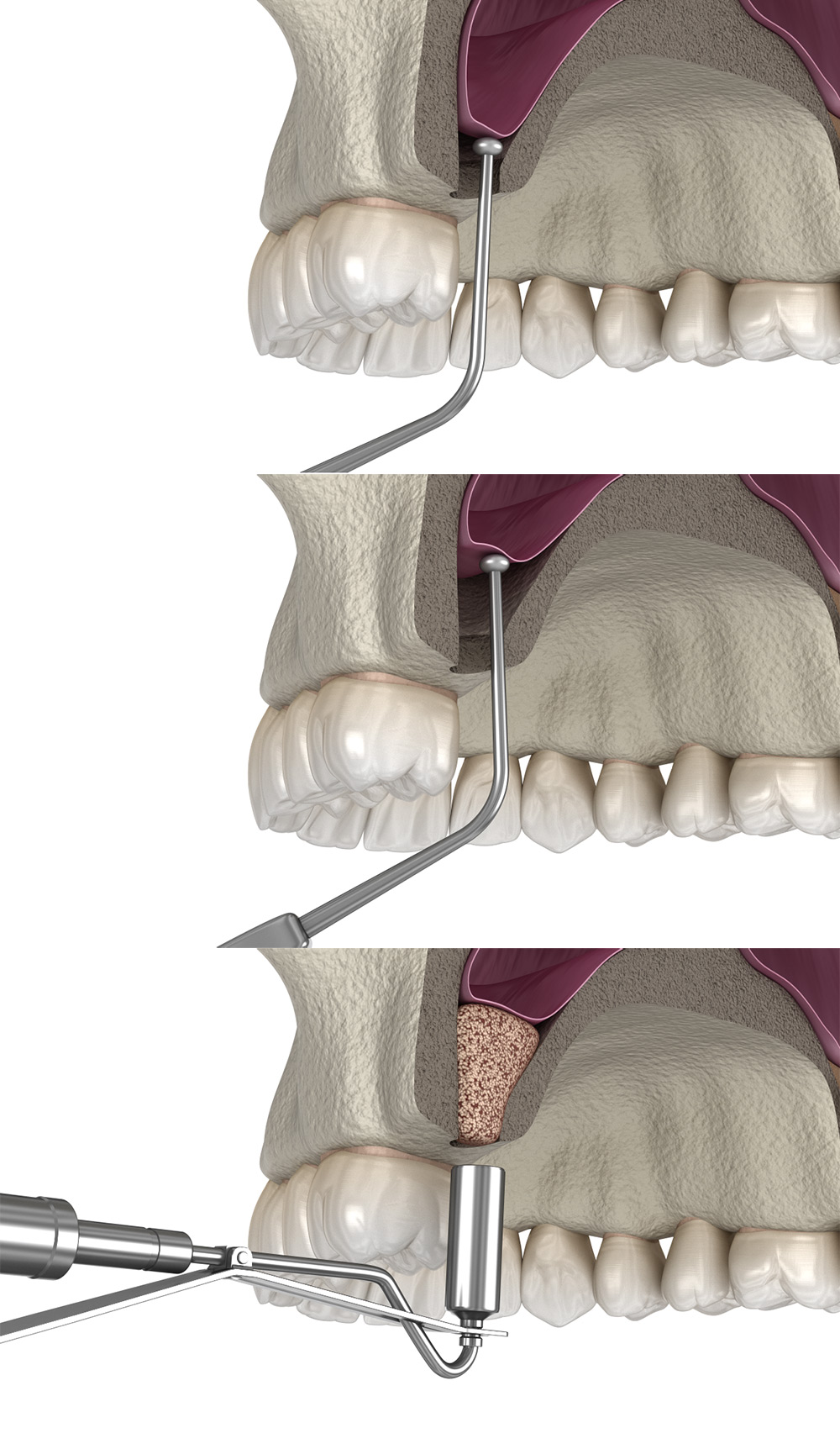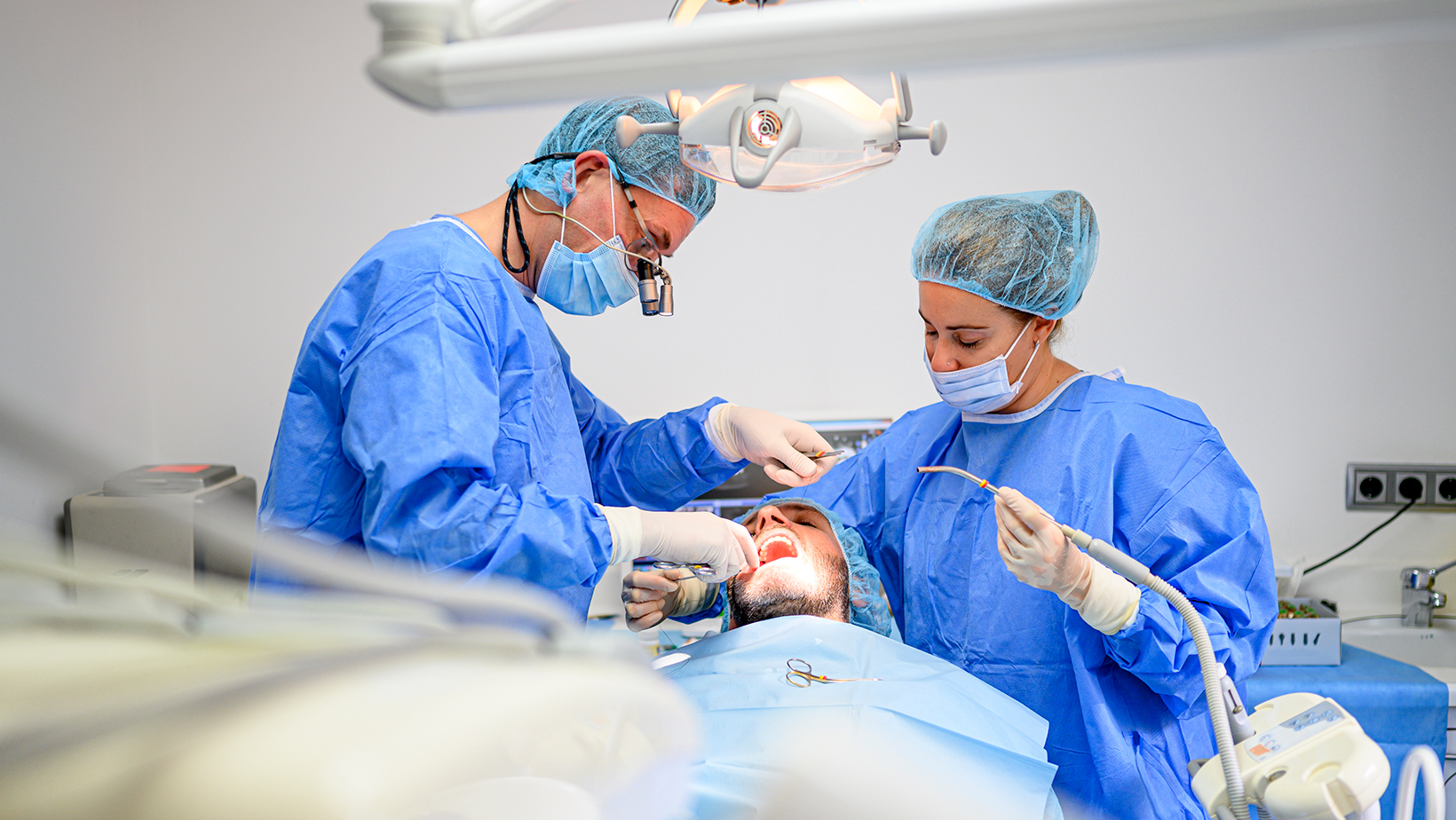When patients are told they need a dental implant, they are often surprised it’s a multi-step procedure. Unlike dentures or bridges which are removable, an implant is permanently placed into the jaw bone — and that bone needs to be strong enough to support it. If the jawbone is weakened for any reason, a procedure called bone grafting is required to rebuild or strengthen the bone using synthetic bone material or bone taken from another area of the body.
Sinus lift surgery becomes necessary if the upper jaw bones (which are close to the sinus cavity) are too weak prior to implant placement. We will discuss what is involved in sinus lift surgery and how it impacts the dental implant procedure.

What is a Sinus Lift?
The maxillary sinuses are located just above the upper back molars. If a dental implant needs to be placed in those areas, there must be enough jaw bone between the gums and sinuses to support the implant. During sinus lift surgery, a surgeon lifts the sinus membrane to add bone or bone-like material between the sinuses and the jaw.
Oral surgeons typically use one of the following sinus lift surgery techniques:
Lateral Window Technique (Direct Sinus Lift Procedure)
In this traditional method, the doctor makes an incision in the gums, exposing the bone. He or she then cuts a “window” into the bone and pushes the piece of bone into the sinus cavity, which lifts the sinuses. Once the sinuses are lifted, the bone graft material is placed into the empty space above the gums. After the incision is sutured closed, it takes about 4-6 months for the bone graft to grow strong enough for implant placement.
Osteotome Technique (Indirect Sinus Lift Procedure)
When patients have more than 6mm of natural bone height and the sinus floor needs to be raised less than 4mm for implant placement, this less invasive technique can be used. The surgeon cuts a flap of gum tissue to form a socket in the bone, then taps the sinus floor into proper position. The dental implant is typically placed during this surgery, and it takes 4-6 months to fully integrate into the bone.

Is a Sinus Lift a Serious Procedure?
Sinus augmentation is considered extremely safe, and complications are rare. It’s usually performed in an oral surgeon’s office under local anesthesia or IV sedation, and doesn’t require hospitalization. However, because the procedure involves sensitive sinus tissue, there are some risks that patients should be aware of, including:
- Tearing or puncturing of the sinus membrane. If this happens, the membrane can be stitched or patched, and surgery will resume when it’s healed.
- Sinusitis that may require surgery
- Allergic reaction to the bone graft
- Tissue or nerve damage
- Scarring
What is Recovery from Sinus Augmentation Like?
Most patients have minimal pain after a sinus lift procedure, and ibuprofen can help alleviate discomfort and reduce swelling around the surgical site. It’s normal to experience light bleeding from the nose and mouth in the hours after surgery. Taking a decongestant or saline spray can keep the nose clear and moist while it’s healing. Doctors usually prescribe antibiotics to prevent infection of the surgical site.
Who is a Candidate for Sinus Lift Surgery?
Not everyone who needs a dental implant requires sinus augmentation. It’s only necessary when there isn’t enough bone in the upper jawbone to create a solid foundation for the implant.
An oral surgeon will suggest a sinus lift in patients who have:
- A naturally small jawbone that isn’t sturdy enough to support the implant
- Sinuses that are too close to the jawbone
- Tooth loss where the space has remained empty long enough to allow bone loss
- Gum disease that has gone untreated and led to bone loss in the jaw
What Happens After Sinus Lift Surgery?
If a patient has had a lateral window sinus lift, they can proceed with the next steps as soon as enough bone has grown between the sinuses and gums to create a strong foundation for an implant.
First, a titanium screw or “implant post” is inserted into the new jawbone to act as the root of the tooth. It takes 3-6 months for the bone to grow around and attach to the screw, which is known as osseointegration. This is what makes dental implants so stable and allows patients to bite and chew with them just as they would a real tooth.
Once the bone is integrated into the screw and the gums have healed, the dentist takes impressions or digital scans of the patient’s mouth to create a customized crown. The crown is designed to match the color, shape, and size of surrounding teeth, giving it a natural appearance.
Finally when the crown is complete, the patient visits the dentist one last time to get the crown attached to the screw to form a functional, attractive tooth!
(Note, If the patient had a sinus lift using the osteotome technique, they will be ready for crown placement as soon as their dental implant is fully integrated into the bone.)
If You Still Have Questions About Sinus Augmentation or the Dental Implant Procedure, Ask a Dentist You Can Trust
With all the steps involved in dental implants, the process can be overwhelming — especially if you’ve been told you will need a sinus lift. If you have any concerns or questions, your oral surgeon should be able to give you honest answers. If you are not getting clear answers or are interested in switching dentists, use our database to find a provider near you.


